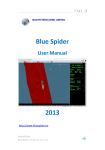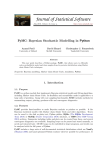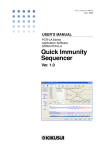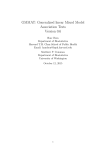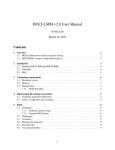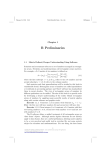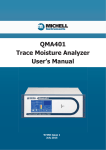Download BayesAss Edition 3.0 User`s Manual
Transcript
BayesAss Edition 3.0 User’s Manual Bruce Rannala c 2007 University of California Davis Last updated 7 October 2011 1 Installation The latest version of BA3 can be downloaded here. Unzip the archive by double clicking the downloaded file. A folder will be created in your current directory containing the program source code, documentation, and precompiled binary files for various computer operating systems. If you have a compiler and are adventurous you can try compiling the source code (see below), otherwise refer to the instructions below to use a precompiled binary file for your specific computer operating system. 1.1 Mac OS X Download the zip archived file with the latest version of the software here. Unzip the archive by double clicking the downloaded file. A folder will be created in your current directory containing the program executable file BA3, example data files (in subfolder examples), and the manual (in subfolder docs). 1.2 Windows A Windows binary for BA3 is not yet available. 1.3 Compiling the program The source code for the program is found in the source tarball distribution file named BA3-*.*.*.tar.gz where * indicate the version numbers. The program uses routines from the gnu scientific library (gsl) and this library (and header files) must be installed prior to compiling. The gsl library can be found here. If using a command line C++ compiler (e.g., g++, c++, etc), with gsl installed, simply execute the following terminal commands in the directory that contains the source tarball: 1 tar -xvzf BA3-*.tar.gz cd BA3-* ./configure ./make all sudo ./make install This should install the executable file BA3 into an appropriate bin directory that is in the user’s default shell path (often /usr/bin or /local/bin) and typing BA3 at the command prompt will then execute the program. The procedures for compiling in Windows using the Cygwin package are essentially identical. 2 Running the program The BA3 program is a command line program. If you are familiar with the unix terminal you will find it straightforward to use as it adheres to standard unix conventions for command line options, etc. If you have never used a terminal (command line) program you can find a beginners guide here. Detailed instructions for running the program on the Mac OS X (or other unix-based) operating system are provided below. 2.1 Getting BA3 up and running on Mac OS X or Unix To run the program, you will first need to start the terminal application which can be found in the Applications/Utilities folder on a Mac. A short tutorial on using the Mac OS X terminal can be found here. The following description assumes that you have unzipped the BA3 distribution file on the Desktop. If you have placed it elsewhere you will need to change the commands to indicate the correct file path. Once you open terminal you will see a command line prompt. On a Mac, at the prompt type: cd /Users/<login>/Desktop/BA3.*/binary/macosx where <login> is replaced with your account login name. On another unix computer you will specify the path to the binary that you unpacked (or compiled from source code). The unix command cd is short for “change directory” and the above command changes the current working directory from the user’s home directory (the default) to the directory where the BA3 program binary resides. To run the program using an example data file with 3 populations (contained in the subdirectory examples) type the following command: ./BA3 -v examples/3pop.txt 2 The prefix ./ means “current directory” and tells the operating system to look for the program file named BA3 in the current working directory. The program option -v specifies “verbose” output and causes BA3 to print out more detailed information to the screen when the program is running. You should see output similar to the following: BayesAss Version 3.0 (BA3) Bruce Rannala Department of Evolution and Ecology at UC Davis Input file: examples/3pop.txt Output file: BA3out.txt Individuals: 400 Populations: 3 Loci: 7 Missing genotypes: 6 Locus:(Number of Alleles) loc0:2 loc1:3 loc2:3 loc3:3 loc4:2 loc5:2 loc6:2 logP(M): -1616.27 logL(G): -3101.46 logL: -4717.74 % accepted: (0.12, 0.23, 0.67, 0.76, 0.60) logP(M): -1617.79 logL(G): -3117.84 logL: -4735.63 % accepted: (0.12, 0.22, 0.67, 0.77, 0.60) logP(M): -1619.86 logL(G): -3085.46 logL: -4705.33 % accepted: (0.12, 0.22, 0.67, 0.77, 0.60) logP(M): -1619.93 logL(G): -3051.05 logL: -4670.98 % accepted: (0.12, 0.22, 0.67, 0.77, 0.60) logP(M): -1616.75 logL(G): -3123.94 logL: -4740.70 % accepted: (0.12, 0.22, 0.67, 0.78, 0.60) logP(M): -1619.99 logL(G): -3079.03 logL: -4699.03 % accepted: (0.12, 0.22, 0.67, 0.78, 0.60) logP(M): -1616.92 logL(G): -3090.25 logL: -4707.17 % accepted: (0.12, 0.22, 0.67, 0.78, 0.60) logP(M): -1616.27 logL(G): -3085.12 logL: -4701.39 % accepted: (0.12, 0.21, 0.67, 0.78, 0.60) logP(M): -1618.92 logL(G): -3122.70 logL: -4741.62 % accepted: (0.12, 0.21, 0.67, 0.78, 0.60) logP(M): -1621.28 logL(G): -3125.25 logL: -4746.53 % accepted: (0.12, 0.21, 0.67, 0.78, 0.60) 3 % done: (0.10) % done: (0.20) % done: (0.30) % done: (0.40) % done: (0.50) % done: (0.60) % done: (0.70) % done: (0.80) % done: (0.90) % done: (1.00) MCMC run completed. Output written to BA3out.txt The program will create an output file in the current working directory when it has finished running. By default the output file is named BA3out.txt. You can double click on this file to open it with the Mac text editor and see the results. 3 Data file format The BA3 program uses an input file format that is identical to that of earlier BayesAss releases. The input file should be in a plain text format. DO NOT use a word processor such as Word to create the input file without explicitly converting it to a text file format before use. One possible approach is to input the data into a spreadsheet program such as Excel and then save the file as a “space-delimited text file.” Another approach is to install one of the many available free text editors such as emacs or vi on your computer. Each line of the input file should have the following format indivID popID locID allele1 allele2 where indivID is a unique identifier for the individual, popID is a unique identifier of the individual’s source population, locID is a unique identifier for the locus, and allele1 and allele2 are the allele labels for each allele of the individual’s genotype. The order of the alleles on the line is arbitrary. Missing alleles are represented using a 0. If there are n individuals and L loci there will be n × L lines in the input file. See the example data files distributed with the program. 4 Command line options The BA3 program has about a dozen command line options that allow you to control the way the program runs and the level of detail in the output that it produces. The command line options are given after the program name and before the input file name. For example, ./BA3 -v -i=10000000 -o myout.txt myin.txt executes the program for 1 million iterations using verbose output, writing the output to the file myout.txt and using the input file myin.txt. Some options such as the option specifying the number of iterations, -i, take parameter values while others such as -v do not. Parameter values should follow the option specifier and may, or may not, be separated from the option specifier by a space or an an = sign. For example, the following are all equivalent ways to specify 1, 000, 000 iterations: 4 ./BA3 -i1000000 myin.txt ./BA3 -i 1000000 myin.txt ./BA3 -i=1000000 myin.txt Table 1 lists all the command line options with a brief description of their parameters and effects. Each option is described in detail in the remainder of this section. Following Unix conventions, each command line option has two possible forms, a short (one letter) form preceded by - and a longer, one word form preceded by --, for example the ”verbose output” command can be specified on the command line as either -v or --verbose. The longer forms are available solely because some persons find them easier to remember. Option -a --deltaA -b --burnin -f --deltaF -g --genotypes -i --iterations -m --deltaM -n --sampling -o- --output -s --seed -t --trace -u --settings -v --verbose Parameter Values 0 < ∆ A ≤ 1.0 Positive integer 0 < ∆ F ≤ 1.0 None Positive integer 0 < ∆ M ≤ 1.0 Positive integer String Positive integer None None None Effect Mixing parameter for allele frequencies Number of iterations to discard as burnin Mixing parameter for inbreeding coefficients Output genotypes and migrant ancestries Number of iterations for MCMC Mixing parameter for migration rates Interval between samples for MCMC Output file name Seed for random number generator Create a trace file to monitor convergence Output options and parameter settings Use verbose screen output Table 1: Options available for BA3 program 4.1 Random number generator seed The option -s (--seed) is used to specify a positive integer used to ”seed” the random number generator algorithm. A deterministic algorithm is used to generate pseudorandom numbers during the MCMC such that the sequence of random numbers is entirely determined by the starting seed. Thus, separate runs of the program started using same seed will produce exactly the same outcome. To test whether the program is converging it is important to carry out several independent runs initiated with different seeds. To start the program using 10456 as the random number seed use the following command: ./BA3 -s=104656 If no seed is specified the default seed is 10. 5 4.2 MCMC iterations, burn-in and sampling interval The command line option -i (--iterations) specifies the number of iterations for the Markov chain Monte Carlo (MCMC) analysis. By default the program uses 5, 000, 000 iterations. The number of iterations is an important factor in determining whether a MCMC analysis has converged (see below). In general, a greater number of iterations will be more likely to insure convergence but the run-time of the program also increases in proportion to the number of iterations. The value of the number of iterations should be a positive integer. For example, .\BA3 -i10000000 test.txt will execute the program using the data file test.txt and carry out 10 million iterations. The option -b (--burnin) is used to specify a positive integer that is the number of iterations of the MCMC that are discarded before sampling begins to obtain a sample of values that will be used to estimate parameters. Burn-in length is chosen such that the chain is likely to have reached the stationary distribution before sampling begins. The burn-in length must obviously be less than the total number of iterations. For example, ./BA3 -i10000000 -b1000000 test.txt will run the MCMC for 10 million iterations, discarding the first 1 million iterations. In this case, 9 million iterations are available for sampling. The option -n (--sampling) is used to specify a positive integer that is the interval between samples. This interval must obviously be less than the number of iterations minus the burn-in, but will typically be much smaller, perhaps 100 or 1000. For example, ./BA3 -i10000000 -b1000000 -n1000 test.txt will run the MCMC for 10 million iterations, discarding the first 1 million iterations and sampling every 1000 iterations from the remaining 9 million iterations, producing a sample of 9000 observations from the chain that will be used to estimate parameters. 4.3 MCMC mixing parameters For continuous parameters such as migration rates, allele frequencies and inbreeding coefficients, the size of the proposed change to the parameter value at each iteration of the MCMC can be adjusted. These adjustments are used to fine-tune the acceptance rates for proposals (see discussion below). There are 3 mixing parameter adjustments: -a (--deltaA), -f (--deltaF) and -m (--deltaM) that adjust the proposal size for the allele frequencies, inbreeding coefficients and migration rates, respectively. Each mixing parameter should be a number between 0 and 1, with the size of the proposed move being proportional to the magnitude of this number. 6 4.4 Options for printing output By default, the output produced by BA3 is written to a file named BA3out.txt that the program creates in the current working directory. An alternative name for the output file can be specified using the option -o (--output). For example, ./BA3 -o myout.txt test.txt executes the program using the input file test.txt and writes the output to a file named myout.txt. The option -t (--trace) specifies whether a trace output file is created that lists all the parameter values at each iteration of the MCMC run. If this option is specified a file named BA3trace.txt is created in the current working directory. This file can be used to monitor convergence of the MCMC by plotting the profile of the likelihood and prior values, as well as those of various parameters, over time, using a program such as Tracer (see below). The option -g causes detailed information regarding the individual multilocus genotypes and posterior probabilities of migrant ancestries to be written to a file named BA3indiv.txt created in the current working directory. The option -u specifies that current values of command line options are printed at the beginning of the output file (recommended). Finally, the option -v (--verbose) specifies that detailed information about the input data (number of populations. number of loci, number of individuals, and so on) is written to the computer screen during the run and that likelihoods and parameter acceptance rates are written to the computer screen as the program runs (recommended). This detailed output can be used to adjust mixing parameters during initial trial runs (see below). It is also useful for checking that the input file is in the correct format and the data are being read correctly by the program. 5 Recommendations for running BA3 To generate correct results using BA3 it is important to adjust the mixing parameters, use a sufficient number of iterations, discard enough iterations as burn-in, and carry out several independent runs (started with different random number seeds), examining the trace files for evidence of convergence and mixing and looking for consistency of the estimates between independent runs. Here I will outline a general strategy for achieving this. I illustrate the strategy using the example data file 3pop.txt. I will begin with an explanation of the screen output generated using option -v. 5.1 Understanding BA3 screen output Running the BA3 program using the command ./BA3 -v examples/3pop.txt produces the following screen output: BayesAss Version 3.0 (BA3) 7 Bruce Rannala Department of Evolution and Ecology at UC Davis Input file: examples/3pop.txt Output file: BA3out.txt Individuals: 400 Populations: 3 Loci: 7 Missing genotypes: 6 Locus:(Number of Alleles) loc0:2 loc1:3 loc2:3 loc3:3 loc4:2 loc5:2 loc6:2 The first two lines of screen output (following the program title) specify the names of the input and output files. The next line prints the number of individuals (in this case, 400), the number of populations (in this case, 3), the number of loci (in this case, 7), and the total number of missing genotypes (in this case, 6). This is followed by a line specifying the number of alleles present at each locus. You should check that all these values agree with the expectations for your data. Discrepancies can indicate that there is a formatting error and the input file is not being read correctly. Once the MCMC begins running the current state of the chain will be printed to screen as follows: logP(M): -1618.76 logL(G): -3087.23 logL: -4705.99 % done: [0.07] % accepted: (0.31, 0.25, 0.66, 0.76, 0.60) The first value logP(M) is the log probability of the current configuration of migrant ancestries among individuals, conditional on the current migration rates. The second value logL(G) is the log-likelihood of the genotype data given the migrant ancestries of individuals and the current population allele frequencies. The third value logL is the sum of these two terms. The value in brackets (or parentheses) after done is the percentage of the total iterations that have been completed. This proportion is displayed in square brackets if the chain is still in the burn-in phase, otherwise it is displayed in parentheses. The final output after % accepted is the acceptance rate for proposed changes to each of the 5 parameters from left to right: (1) migration rates; (2) individual migrant ancestries; (3) allele frequencies; (4) inbreeding coefficients; (5) missing genotypes. 5.2 Adjustment of mixing parameters The acceptance rates for proposed changes to parameters 1, 3 and 4 in the above list (migration rates, allele frequencies and inbreeding coefficients, respectively) can be adjusted by changing the values of the respective mixing parameters. If the acceptance rate is too high, the chain does not mix well, often proposing values very near the current value 8 (which are accepted) and failing to adequately explore the state space. If the acceptance rate is too low the chain rarely accepts the proposed moves which are too different from the current value – this also causes poor mixing. Empirical analyses suggest that an acceptance rate between 20% and 40% is optimal. In the above example, the acceptance rate for proposed changes to migration rate is about 31 % which is adequate. However, the acceptance rates for proposed changes to the allele frequencies and inbreeding coefficients are 66% and 76% respectively, which are both too high. One can decrease the acceptance rate by proposing larger moves (or increase the rate by proposing smaller ones). In this case, we want to decrease the acceptance rate so we will try increasing the proposal step size for the mixing parameters associated with proposed moves of both the allele frequencies and inbreeding coefficients. The default values of all the mixing parameters are 0.10. We will try increasing the proposal step length to 0.30 for both these proposals. Stop the program by typing Control-C in the terminal, then start it again using the following command options: ./BA3 -v -a0.30 -f0.30 examples/3pop.txt The output from the MCMC run is now as follows: logP(M): -1618.75 logL(G): -3142.41 logL: -4761.16 % done: [0.07] % accepted: (0.31, 0.24, 0.31, 0.45, 0.60) This is much better, but the acceptance rate for proposed changes to the inbreeding coefficients is still a bit high at 45%. We therefore again kill the program run using Control-C and try again with the following mixing parameters: ./BA3 -v -a0.30 -f0.50 examples/3pop.txt The output from the MCMC run is now as follows: logP(M): -1618.38 logL(G): -3115.25 logL: -4733.63 % done: [0.08] % accepted: (0.31, 0.24, 0.32, 0.33, 0.60) The acceptance rates now look okay so we will next try some longer runs with these values for the mixing parameters and create a trace file to examine convergence. 5.3 Diagnosing convergence Enter the following to initiate a longer run with the random seed 100, creating a trace file and printing the output to a file named run1out.txt: ./BA3 -v -a0.30 -f0.50 -t -s100 -i10000000 -b1000000 -n100 \ -o run1out.txt examples/3pop.txt The contents of the output file run1out.txt are as follows: 9 Input file: examples/3pop.txt Individuals: 400 Populations: 3 Loci: 7 Locus:(Number of Alleles) loc0:2 loc1:3 loc2:3 loc3:3 loc4:2 loc5:2 loc6:2 Population Index -> Population Label: 0->pop0 1->pop1 2->pop2 Migration Rates: m[0][0]: 0.9718(0.0115) m[0][1]: 0.0130(0.0100) m[0][2]: 0.0152(0.0090) m[1][0]: 0.0878(0.0141) m[1][1]: 0.7338(0.0396) m[1][2]: 0.1784(0.0407) m[2][0]: 0.0870(0.0179) m[2][1]: 0.2047(0.0326) m[2][2]: 0.7083(0.0292) Inbreeding Coefficients: pop0 Fstat: 0.2552(0.0367) pop1 Fstat: 0.0810(0.0588) pop2 Fstat: 0.2698(0.0891) Allele Frequencies: pop0 loc0>> 2:0.806(0.029) loc1>> 3:0.309(0.033) loc2>> 2:0.751(0.031) loc3>> 2:0.384(0.035) loc4>> 1:0.825(0.028) loc5>> 2:0.234(0.031) loc6>> 2:0.237(0.031) 1:0.194(0.029) 2:0.601(0.035) 1:0.089(0.020) 3:0.170(0.027) 1:0.078(0.018) 1:0.292(0.032) 3:0.324(0.032) 2:0.175(0.028) 1:0.766(0.031) 1:0.763(0.031) 10 pop1 loc0>> 2:0.512(0.065) loc1>> 3:0.323(0.068) loc2>> 2:0.222(0.062) loc3>> 2:0.663(0.069) loc4>> 1:0.266(0.071) loc5>> 2:0.750(0.049) loc6>> 2:0.868(0.058) pop2 loc0>> 2:0.479(0.077) loc1>> 3:0.451(0.083) loc2>> 2:0.195(0.070) loc3>> 2:0.465(0.069) loc4>> 1:0.121(0.068) loc5>> 2:0.862(0.053) loc6>> 2:0.779(0.062) 1:0.488(0.065) 2:0.445(0.070) 1:0.232(0.075) 3:0.593(0.061) 1:0.186(0.054) 1:0.325(0.071) 3:0.012(0.012) 2:0.734(0.071) 1:0.250(0.049) 1:0.132(0.058) 1:0.521(0.077) 2:0.176(0.068) 1:0.374(0.080) 3:0.433(0.077) 1:0.372(0.072) 1:0.506(0.069) 3:0.029(0.017) 2:0.879(0.068) 1:0.138(0.053) 1:0.221(0.062) The first few lines of output summarize properties of the data. Next, there is a line that maps an integer index to each population label. This is done simply to allow the between population migration matrix to be printed more concisely. Next is the matrix of inferred (posterior mean) migration rates and the standard deviation of the marginal posterior distribution for each estimate. A rough 95% credible set can be constructed as mean ± 1.96 × sdev. Next are the mean posterior estimates (and standard errors) of inbreeding coefficients and allele frequencies for each locus and population. Two simple ways to examine convergence are: (1) conduct multiple runs initialized with different seeds and 11 compare the posterior mean parameter estimates for concordance. (2) Analyze the trace file for each run using the Tracer program (available here). The trace file for the logprobability of the above run is plotted in Figure 1. The burn-in iterations are indicated in light grey, sample iterations in black. Two things should be observed. First, the logprobability initially increases steeply during the burn-in phase but then oscillates around a plateau – this is often (but not always) the case when a chain as converged. Second, the oscillations are quite regular – there are no persistant lows or highs (valleys or hills) in the plot – this is one indication that the chain is mixing well and effectively sampling from the posterior distribution with less autocorrelation between successive samples of the chain than would be the case if valleys and hills existed. Figure 1: Trace file for log probability in a BA3 analysis of example input file 3pop.txt created using the Tracer program 12














